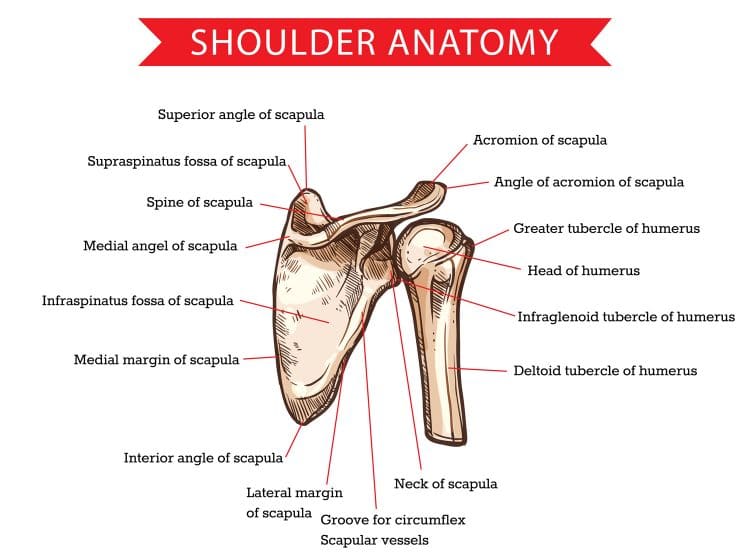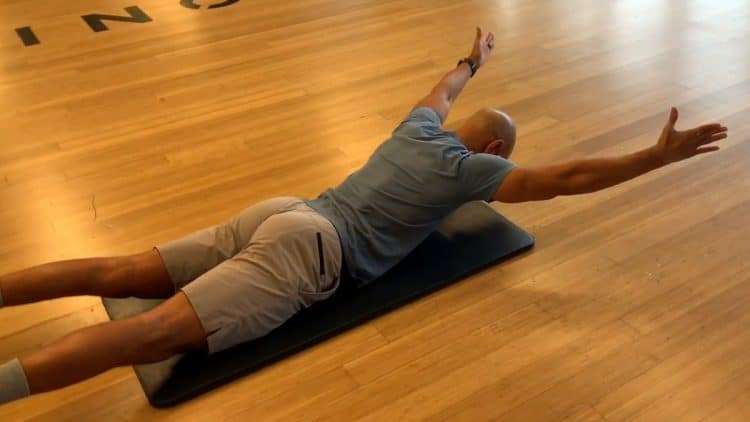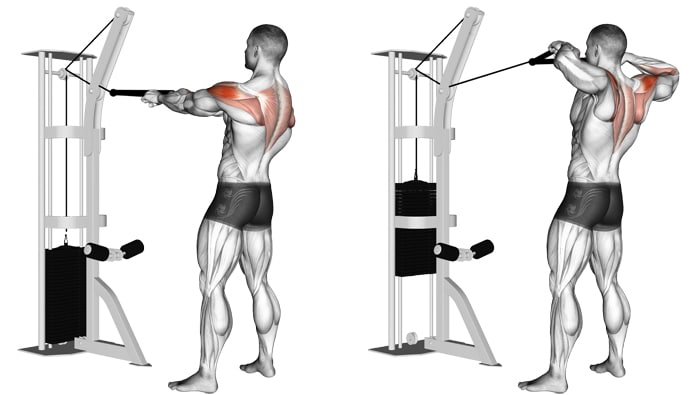The scapula (plural scapulae) is the large, flat bone most people know as their shoulder blade. There are two scapulae bones that connect to your upper arms and clavicles to form your shoulder girdle. The scapulae are affected by 17 different muscles and are capable of several movements, including
- Protraction
- Retraction
- Elevation
- Depression
- Upward rotation
- Downward rotation

While most exercisers focus almost exclusively on their muscles during their workouts, the action of the scapulae is also very important. The position of the scapulae can affect the movement of your shoulders, and correct scapulohumeral rhythm is critical for long-term shoulder health.
For example, if your scapulae rise up during upper body pressing exercises, you risk compromising your shoulder joint and could experience shoulder pain. Similarly, if your shoulder girdle is pulled forward during rows, your back workout will lose some of its effectiveness.
Because of this, we almost always include the cue “keep your shoulders down and back” in our exercise instructions. This creates more scapular awareness and should ensure that you start each set with your scapulae positioned correctly.
However, with so many muscles affecting the position of your scapulae, muscle weakness can limit your control over these vital bones. An example of this is scapular winging, where the medial border of the scapulae sticks out like a fin.

Poor scapular control can also make simple tasks like raising your arm overhead difficult and even uncomfortable. In addition, it can weaken your bench press and make biceps curls less effective.
That’s because your scapulae are the foundation for many so muscles and movements. If your scapulae aren’t stable, your muscles will not be able to generate maximum force, and your movements will be less efficient. Unstable scapulae need fixing!
So, in this article, we reveal the 15 best exercises for improving scapular stability.
15 Best Scapular Stabilizer Exercises
Does your upper back feel unstable? Do you find it hard to control your shoulders during presses and rows? Do your shoulders rise up and forward when you know they should be down and back?
Then you need to work on your scapular stability! Here are 15 of the best scapular stability exercises.
- Wall ball circles
- Forearm wall slides
- Plank with protection
- Push-up plus
- Serratus bench press
- Reverse shrugs
- Scapular pull-ups
- Overhead carries
- Incline prone shoulder press
- YTAs & YTWs
- Face pulls
- Band pull-aparts
- Wall angels
- Victory dumbbell raises
- Cuban press
1. Wall ball circles
Target muscles: Serratus anterior, pectoralis minor, rotator cuff.
Wall ball curls teach you to set your scapular while strengthening the muscles responsible for keeping your shoulder blades flat against your ribs. This exercise is a great way to warm up your shoulder girdle before moving on to more demanding upper-body exercises, e.g., bench presses or pull-ups. It’s also an excellent prehab/rehab shoulder exercise.
Steps:
- Stand facing a smooth wall and hold a stability ball in front of you. Using one hand, press the ball against the wall so your arm is straight and your body is upright.
- Gently pull your shoulders down and back and place your non-working hand behind you, using your fingers to locate and lightly touch your scapula.
- Move the ball in small circles using your palm, doing half your reps clockwise and half counterclockwise.
- Switch hands and repeat with the other arm.
Tips:
- Shrug your arm forward and press your hand into the ball to fully engage your serratus anterior and pec minor muscles.
- Increase the size of the circles to make this exercise more demanding.
- You can also do this exercise with a light medicine ball to make it more challenging.
2. Forearm wall slides
Target muscles: Serratus anterior, pectoralis minor, rotator cuff.
Forearm wall slides take the strength developed during exercise #1 and increase your range of motion. They teach you to keep your shoulders down and back during overhead presses and mobilize your shoulders while stretching your lats. If you find front squats hard to do, this exercise will undoubtedly help.
Steps:
- Stand in front of a smooth wall. Bend your arms and place your forearms against the wall with your arms parallel and roughly shoulder-width apart. Your hands should be neutral and level with your eye line.
- Pull your shoulders down and back, and brace your core.
- Keeping your scapulae pinned together, slide your forearms up the wall as high as possible. Allow your arms to separate toward the top of the movement to form a Y shape.
- Lower your arms and repeat.
Tips:
- Increase your range of motion as your shoulders and lats begin to warm up.
- Keep your core engaged and lean into the wall to make this exercise more effective.
- Wear a shirt with long sleeves to make this exercise smoother and more comfortable to perform.
3. Plank with protraction
Target muscles: Core, serratus anterior, pectoralis minor, rotator cuff.
The plank is an excellent and popular core exercise. Still, you can easily modify it to work your scapulae stabilizers, too. This is an awesome option for anyone who finds stationary planks boring and would prefer to count reps instead of time. It’s also a great time-saving twofer as it combines two exercises into one.
Steps:
- Kneel down and place your forearms on the floor, so they’re parallel and about shoulder-width apart.
- Walk your feet out and back and get into the classic plank position. Brace your core.
- Drive your elbows and forearms into the floor and shrug your shoulders forward. Imagine you are spreading your scapulae apart. Hold for three seconds.
- Next, allow your shoulders to return to their usual position. Again, hold for three seconds.
- Push your shoulders forward again and repeat for the desired number of reps.
Tips:
- You can also do this exercise with straight arms, i.e., a high plank.
- Bend your legs and rest on your knees to make this exercise easier.
- Make planks with protraction harder by placing your forearms on a stability ball.
4. Push-up plus
Target muscles: Pectoralis major, deltoids, triceps, core, serratus anterior, pectoralis minor, rotator cuff.
Push-ups are one of the most popular and widely performed exercises in the world. They work your chest, shoulders, and triceps. However, with a simple modification, you can turn the humble push-up into a challenging scapular stability exercise. If you do push-ups, make them even better by adding a plus!
Steps:
- Kneel down and put your hands flat on the floor, fingers pointing forward and roughly shoulder-width apart.
- Walk your feet out and back, so your legs and body are straight. Brace your core.
- Bend your arms and lower your chest to within an inch of the floor.
- Extend your arms and drive your palms into the floor, shrugging your shoulders forward at the top of your rep.
- Return your shoulders to neutral and then do another rep.
Tips:
- Bend your legs and rest on your knees to make this exercise easier.
- Raise your feet to put more weight on your hands and make the exercise harder.
- Rotate between close, medium, and wide hand positions to work your muscles from a variety of angles.
5. Serratus bench press
Target muscles: Pectoralis major, deltoids, triceps, core, serratus anterior, pectoralis minor, rotator cuff.
The bench press is a popular exercise but can also cause shoulder pain. Many of these problems come from improper scapular setting. Ideally, your shoulders be down and back to give your pecs a stable base to work from. However, you can also use the bench press to strengthen your serratus anterior and associated muscles. Include this exercise in your bench press warm-up to get these muscles firing correctly.
Steps:
- Lie on the bench and hold the bar with an overhand, medium-width grip. Unrack the bar and hold it over your chest.
- Keeping your arms straight, drive your shoulders forward and push the bar up toward the ceiling.
- Next, lower your shoulders back down and into the bench.
- Shrug your shoulders forward again and repeat.
Tips:
- You can also do this exercise with dumbbells, either singularly or in pairs.
- No bench? No problem! You can do serratus floor presses instead.
- Don’t use heavy weights for this exercise. Instead, focus on the movement of shrugging your shoulders forward.
6. Reverse shrugs
Target muscles: Lower trapezius, latissimus dorsi, forearms.
Also known as lat shrug downs, this exercise targets your lower traps which are responsible for holding your shoulders in a depressed position. Weak lower traps mean your shoulders are more likely to lift up when they should be down or neutral. Do this exercise before overhead presses, pull-ups, or pulldowns to fire up your lower traps.
Steps:
- Hold the lat pulldown bar with an overhand, shoulder-width grip. Sit on the lat pulldown machine seat with your feet flat and legs under the knee pads.
- Sit up tall, extend your arms, and lift your chest. Your lower back should be slightly arched.
- Without bending your elbows, squeeze your shoulder blades down and together. Imagine you are trying to “put your scapulae in your back pockets.”
- Raise your shoulders are far as possible and repeat.
Tips:
- Rotate between a wide, medium, and narrow grip to work your lower traps from a range of angles.
- Use light weights so you can focus on performing the movement as strictly and smoothly as possible.
- Keep your arms straight throughout. Do not pull with your biceps.
7. Scapular pull-ups
Target muscles: Lower trapezius, latissimus dorsi, forearms.
Scapular pull-ups are a bodyweight version of reverse shrugs. They’re a good option for strong exercisers and for use during your pull-up/chin-up warm-up. While you may not be able to do as many reps, you can make up for this by holding the peak contraction of each rep for longer, e.g., 3-5 reps of 3-5 seconds.
Steps:
- Hang from a pull-up bar using an overhand, shoulder-width grip. Your arms should be straight and your feet clear of the floor.
- Without bending your arms, pull your shoulders down and back and lift your chest up toward the bar. Hold the top position for a second or two.
- Return to your starting position and repeat.
Tips:
- Use lifting straps or gym chalk to reinforce your grip if necessary.
- Use a resistance band for assistance if required.
- Try wide, regular, and narrow grip positions to see which feels most effective and comfortable.
8. Overhead carries
Target muscles: Upper trapezius, deltoids, triceps.
Overhead carries develop your scapular stability for better, safer shoulder presses. Overhead pressing can be hard on your shoulder joints if your shoulder girdle is not as stable as it should be. With practice, you should be able to work up to using pretty heavy weights for this exercise. However, at first, start light because balancing weights overhead is not easy.
Steps:
- Press and hold two dumbbells or kettlebells overhead. Your palms should be neutral.
- Squeeze your shoulders back and brace your core.
- Keeping your arms straight, go for a walk around your training area. Use your shoulders to control the weights and keep your arms vertical.
Tips:
- You can also do this exercise with a barbell.
- Walk in a figure-eight to increase the stabilizer demands of this exercise.
- Use one weight to increase core activation while working on scapular stability, like this:
9. Incline prone shoulder press
Target muscles: Middle and lower trapezius, rhomboids, deltoids, triceps.
This unusual exercise works your deltoids and upper back while teaching you how to keep your scapulae depressed and retracted. It’s a challenging exercise that will quickly improve scapular stability and strength.
Steps:
- Adjust your exercise bench to 45 degrees. Lie face down on the bench with your head uppermost.
- Hold a dumbbell in each hand and raise them to your shoulders, palms facing down. Pull your shoulders down and back.
- Press your dumbbells forward and up, so your arms form a straight line with your body.
- Return the weights to your shoulders and repeat.
Tips:
- Go light – this exercise is much more strenuous than it looks!
- You can also do this exercise with a stability ball instead of a bench.
- Do this exercise lying flat on the floor if you don’t have a bench/ball available.
10. YTAs & YTWs
Target muscles: Middle and lower trapezius, rhomboids, deltoids.

YTAs and YTWs are two similar bodyweight floor exercises for your scapulae stabilizers. They’re also excellent for improving your posture, shoulder mobility, and general upper-body joint health.
Because you don’t need any equipment to do either of these exercises, they’re ideal for home exercisers and home-based prehab and rehab workouts. After all, not everyone has time to add scapular stability exercises to their gym workouts.
Learn more about YTAs here and how to do YTWs here.
11. Face pulls
Target muscles: Middle trapezius, rhomboids, posterior deltoids.
Face pulls are an excellent upper back and posture exercise that is also good for strengthening your scapular retractors. This exercise teaches you how to pull your shoulders back and keep them there as you move your arms in and out.

Steps:
- Attach a rope handle to a chest-high pulley machine.
- Take one end of the rope in each hand and step back with your arms straight. Use a staggered stance for balance. Brace your core and pull your shoulders down and back.
- Bend your arms and pull your hands into the side of your head. Imagine you are trying to poke your thumbs in your ears.
- Extend your arms and repeat.
Tips:
- Externally rotate your arms to form a W-shape and increase external rotator engagement.
- Go light and focus on performing the movement correctly rather than lifting heavy weights with poor technique.
- Keep your elbows up to avoid accidentally recruiting your lats more than your scapular retractors.
12. Band pull-aparts
Target muscles: Middle trapezius, rhomboids, posterior deltoids.
The great thing about band pull-aparts is how convenient they are to add to your workouts or work or home schedule. Keep a band nearby so you can do a set whenever you have a few minutes spare.
Steps:
- Hold a resistance band with an overhand, slightly less than shoulder-width grip.
- Raise your arms out in front of you, so your arms are parallel to the floor.
- Pull your shoulders down and back and then open your arms and stretch the band out across your chest.
- Return to the starting position and repeat.
Tips:
- Use a light band and do 100 reps daily to keep your shoulders healthy and maintain good posture.
- Experiment with the position of your arms to hit your muscles from a range of angles.
- Do some pull-aparts between sets of bench presses or push-ups or even as part of your upper body warm-ups.
13. Wall angels
Target muscles: Lower and middle trapezius, rhomboids, deltoids.
Wall angels target your entire upper back, including those all-important scapular stabilizers. Using gravity and your own chest muscles for resistance, this is also an excellent postural exercise. Do them at home, work, in your hotel room, or even in your jail cell (!); they’re the perfect excuse-free scapular stability exercise.
Steps:
- Stand with your back against a wall, feet about 12-18 inches away. Press your shoulders, head, and glutes against the wall.
- Raise your arms and bend your elbows to 90 degrees. Put your arms, forearms, and the backs of your hands flat against the wall.
- Pressing your arms back onto the wall, slide your arms as far up as possible.
- Slide your arms down the wall and repeat.
Tips:
- Wear a long-sleeved shirt to make this exercise smoother and easier.
- If standing wall angels are too challenging, you can do this exercise on a smooth floor.
- You can also do this exercise while seated, like this:
14. Victory dumbbell raises
Target muscles: Primary: Trapezius, deltoids, rhomboids.
Victory dumbbell raises are on of the few exercises that work all three deltoids equally. In addition, they require and develop plenty of scapular stability. If you only do one exercise for your shoulder and upper back stability and health, this exercise should be it!
Steps:
- Put a small resistance band (mini-band) around your wrists and hold a dumbbell in each hand. Adopt a neutral or palms-in grip.
- Stand with your feet shoulder-width apart, knees slightly bent, core braced, and shoulders down and back.
- Press your arms outward against the band and raise them forward and upward to make a Y-shape above your head.
- Lower your arms, and bring your hands back together.
- That’s your first rep – keep going!
Tips:
- Move slowly to fully engage the target muscles.
- Pause with your arms raised to increase the stability demands of this exercise.
- Keep pushing your hands outward to keep tension on your muscles the entire time.
15. Cuban press
Target muscles: Trapezius, rhomboids, deltoids, biceps, rotator cuff.
The Cuban press was once the “secret” shoulder prehab/rehab exercise of Cuba’s Olympic weightlifting team. It was also popularized by famous old-school Cuban bodybuilder, three-time Mr. Olympia winner, Sergio “The Myth” Oliva. This exercise works your deltoids and scapular stabilizers. It’s an excellent move for time-pressed lifters.
Steps:
- Hold a barbell in front of your hips using an overhand, slightly wider than shoulder-width grip.
- Stand with your feet about hip-width apart, knees slightly bent, core braced, and shoulders pulled down and back.
- Bend your elbows and row the barbell to your sternum/lower chest. Your upper arms should be roughly parallel to the floor, elbows bent to 90 degrees.
- Next, externally rotate your shoulders and raise the bar up so it’s just above your head.
- Press the bar up above your head.
- Lower the bar back to the start by doing the same movement in reverse.
Tips:
- Adjust the position of your hands to see what feels most comfortable/effective.
- Skip the overhead press part if it bothers your shoulders.
- You can also do Cuban presses with dumbbells, like this:
Scapular Stabilization FAQs
Do you have a question about scapular stabilization exercises? That’s cool because we’ve got the answers!
1. What is scapular setting, and why does it matter?
Scapular setting is the action of getting your scapulae into the correct position before starting your set. Invariably, this means pulling your shoulders down and back. Doing this at the start of each set will help strengthen your mind-muscle connection and give your other muscles a solid foundation from which to work.
Practice setting your scapulae whenever the opportunity arises so it becomes second nature during your workouts.
2. When is the best time to work on scapular stability?
You can work on scapular stability at various times of the day. Good opportunities include:
- On rising
- As part of your warm-up
- In a dedicated shoulder stability workout
- Between the main exercises of your upper or lower-body workout
- To break up long periods of sitting
- Before going to bed
Ultimately, there is no single best time. Rather, you should work on scapular stability whenever it’s convenient and can do it consistently. 2-3 sets of 1-2 different exercises are all you need.
3. How many reps per exercise should I do?
Unfortunately, this question is impossible to answer. We don’t know what weights you can handle or what equipment you have available. However, most scapular stability exercises work best with light to medium loads and medium to high reps, e.g., 12-20. This will allow ample time to perfect your technique and keep your muscles under tension.
Whenever you are unsure how many reps to do, just keep going until you feel like you are within a couple of reps of failure. This is typically when your movements start to slow down, and your technique just begins to falter.
This should be sufficient to trigger the increases in strength you’re looking for.
4. Is scapular stabilization really that important?
Scapular stability is a lot like core stability. When your core is strong, keeping your lumbar spine locked in place is much easier so you can lift heavy weights safely and without your lower back rounding.
Similarly, scapular stability helps fix your shoulder girdle in place so your arms have a solid platform from which to work. An unstable shoulder girdle will undermine all of your upper body training and could even lead to injuries.
So, yes – scapular stability really IS that important!
5. What muscles attach to the scapulae?
There are 17 muscles attached to the scapulae. This is why scapular stabilization and setting are so important, as the position of your scapulae affects so many different muscles. The muscles that attach to the scapulae are (1):
- Subscapularis
- Supraspinatus
- Infraspinatus
- Teres minor
- Teres major
- Deltoids
- Latissimus Dorsi
- Trapezius
- Serratus anterior
- The long head of the biceps brachii
- The long head of the triceps brachii
- Coracobrachialis
- Pectoralis minor
- Levator scapulae
- Rhomboids minor
- Rhomboids major
- Omohyoid
Closing Thoughts
Scapular stability training might not be sexy or exciting, but it could make your workouts safer and more productive. For example, more stable scapulae can help reduce your risk of shoulder pain and thoracic outlet syndrome and boost your bench press and biceps curl performance.
You don’t have to dedicate a lot of time to scapular stabilization, and 10-15 minutes a couple of times a week should be all you need. However, unstable scapulae could make your workouts much less effective, so your investment will pay off.
Use these 15 exercises to make sure your scapulae are rock-solid, giving your upper body muscles a strong and stable platform from which to work.
References:
- Scapula. (n.d.). Physiopedia. https://www.physio-pedia.com/Scapula


